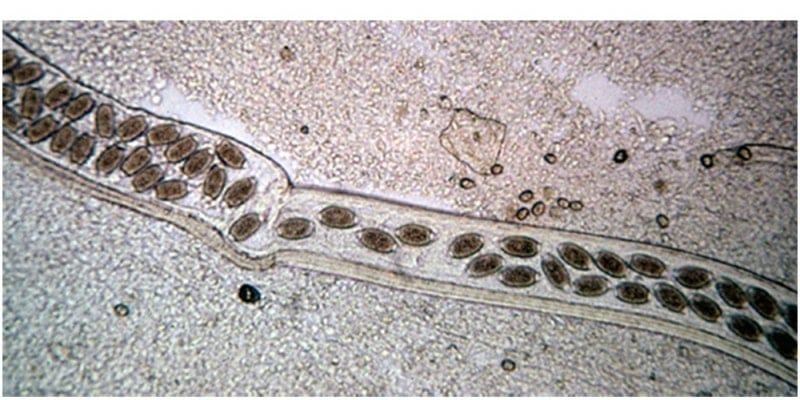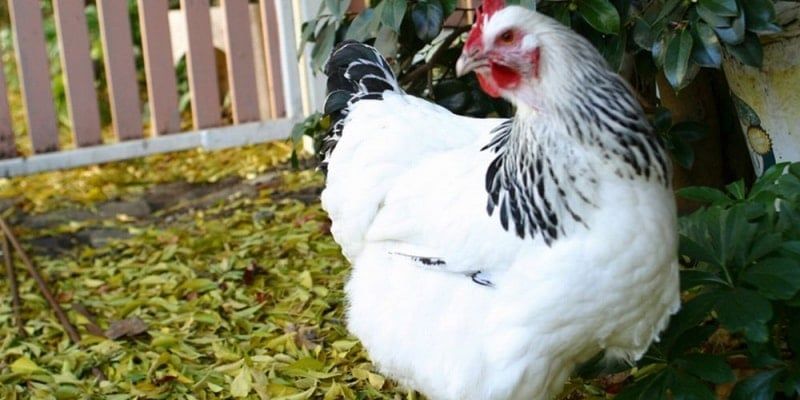To Worm or Not to Worm?


The question of when to worm
One of the more common questions people ask is: “Should we worm our chickens?” Like most things in medicine, the answer is: “It depends …”
While birds that are heavily parasitized, or infested, with worms can cause disease, “normal” loads of most worms are relatively harmless. In fact, having some worms is important to help generate a robust immune response. This means that treatment needs to be based on clinical signs consistent with worm infestation and, in some cases, a clinical diagnosis.
This approach helps reduce the potential for resistance to de-wormers and helps avoid loss of eggs associated with post-treatment withdrawal times. This article will provide some basic information on common worms, how to prevent them, and when to treat.
Know your enemy
Internal poultry parasites, or worms, are very common and, at some point, most chicken owners have to deal with them. It’s important to realize that all worms are not created equal, making identification an important step when assessing the significance when finding worms.
Chickens get several types of worms, but for backyard are typically limited to five common types. These include large roundworms, thread of capillary worms, cecal worms, tapeworms, and gape-worms. Table 1 (see [NEED ORIENTATION]) lists the most common worms along with the typical diagnostic and clinical signs associated with them.
In general, these types of parasites have low mortality, meaning they don’t typically kill their hosts. However, heavily parasitized birds may be droopy, emaciated, and show signs of diarrhea. In addition, severe cases can cause impaired feed efficiency and production. In extreme cases (i.e. heavy parasitic loads and co-infections) some worms can cause relatively high mortality rates. The following is a brief description of the most common worms mentioned above and in Table 1.
Roundworms – or ascarids, are very common in backyard poultry. Adult worms are about one and a half to three inches long by approximately an eighth of an inch wide. Extensive infection may reduce egg production. Death may occur due to intestinal obstruction in birds that are immunosuppressed or have a co-infection with a second disease.
Capillary worms –or Capillaria, are found in the crop or esophagus. Capillaria eggs are found in the lining of the intestines. They may cause thickening or inflammation of the crop tissue and focal lesions in the intestinal tract. Severe infestation may lead to mortality.
Cecal worms – are found in the ceca of chickens which are in the lower gastro-intestinal tract. The worms themselves are not considered a major threat but they are a carrier for the agent that causes blackhead disease, or histomoniasis, which affects chickens but is primarily associated with mortality in turkeys. Consequently, turkeys should not be raised in the same environment as chickens since the chickens may be carriers of the relatively common cecal worms.
Tapeworms – or Cestodes, are flattened, ribbon-shaped worms composed of numerous segments or divisions that live primarily in the intestinal tract. Tapeworm infections result in emaciation in mature flocks, especially if severe infestation is exacerbated by malnutrition or immunosuppression. Depending on the species, tapeworms can grow more than five inches.
Gapeworms – or Syngamus, are found in the trachea and respiratory tree. Gapeworms are also called “forked worms” because the male and female worms are always locked in copulation and form a “Y.” The term “gapeworm” comes from a heavily-infected bird’s tendency to gasp or “gape.” The worms can grow up to one inch and are capable of blocking the trachea and causing suffocation. Chicks are believed to be the most susceptible because of their relatively small trachea.
Diagnosis
The worm listed above can be diagnosed in a variety of ways. With a high load, roundworms and tapeworms can be seen with the naked eye in feces. Eggs from worms that are present in the GI tract can be identified by taking a fresh fecal sample to your veterinarian and asking for a fecal flotation test or a fresh smear of feces. Post-mortem examination of mucosal scrapings of affected tissue (respiratory or intestinal) can also be used as a way to gauge the health status of the remainder of your flock.
How birds are infected
Worms can be picked up from the feces of other chickens or birds—including wild birds. Often insects act as the intermediate host by carrying the worm eggs, which are then deposited in the chicken after they ingest the insect. In general, worms can be found in the respiratory or intestinal tract.
Breaking the cycle
Prevention of disease is always more desirable than treatment—this rings especially true for backyard poultry. To do this we need to understand the environmental conditions worms thrive in along with how they reproduce and infect their host.
While worms and their eggs will always be present at some level within the poultry environment, you can mitigate their ability to cause disease with proper husbandry and management of your flock and their environment. In general, control measures should be focused on sanitation, interruption of the life cycle, and the strategic use of efficacious de-wormers.
Basic measures
Helpful tips to minimize risk
- Keep the coop and surrounding area clean. Lack of cleanliness is a common cause of poultry disease. There are several general sanitation measures that should be taken, including: the complete cleaning and disinfecting of house and equipment before starting baby chicks or housing layer; daily cleaning of waterers; and keeping litter dry and clean. For example, one way to help control tapeworms is by reducing the flies that act as intermediate hosts. And a good way to control flies is through proper manure management and overall general cleanliness.
- If at all possible, after a heavy infection, move your flock to land that hasn’t been occupied by chickens. Any area that has manure on it consistently will eventually have a high load of bacteria, viruses, and parasites.
- Practice good biosecurity. Worm eggs can be introduced into new facilities through contaminated equipment. Make sure to not share equipment with other flocks before properly disinfecting it.
- In addition, controlling worms can be difficult in backyard flocks due to the common presence of mixed-aged flocks. In mixed-aged flocks, older, apparently “healthy” chickens can shed eggs in their feces and subsequently infect the younger chicks. If you do have mixed-aged flocks, consider treating or testing the older birds before introducing chicks.
When and how to treat
In general, eggs and poop should be the only things coming out of the vent. If you also see worms, then that is a good indication of an unhealthy worm burden. If one or two of your chickens have high worm burdens, the entire flock should be treated since all of the chickens share the same environment.
While there are other medications that are effective against internal parasites, Piperazine is the only FDA approved treatment for internal parasite in meat and egg producing birds. Resistance does occur, so it’s important to use only when necessary, such as after you see or diagnose worms or have seen clinical signs. Piperzine is added to drinking water. Special care should be takes to use de-chlorinated water (Note: this should be done with any medication added to water). For any drug, it is important to refer to the Food Animal Residue Avoidance Databank (www.farad.org) with respect to the most up to date information on withdrawal times for eggs and meat which may be different.
Other drugs, including Fenbendazole and Levamisole, have proven to be efficacious against roundworms, capillary worms, cecal worms, and gapeworms. While these drugs have not been approved by the FDA for this use, recent regulatory changes concerning the extra-label use of drugs make it easier for veterinarians to prescribe “unapproved” drugs while under their supervision.
It is important to recognize that while Piperazine has a relatively wide spectrum of activity, it isn’t effective against all of the different worms we’ve discussed here. Another concern is that different worms can develop resistance to Piperazine and other treatments over time. Consequently, use of Piperzine and other de-wormers should be done to treat a specific problem, meaning scheduled “worming” may not be advisable. Before you worm, ask yourself, “Why?”
Can I become infected?
The worms mentioned above are not “zoonotic,” meaning they don’t cause disease in humans. However, it is possible for these worms to carry pathogenic bacteria, such as Salmonella. Therefore, always wash your hands after handling your chickens (see “Don’t Play Chicken With Your Health” on page [NEED PAGE] to learn more).
It’s also important to realize that there are several other diseases which chickens carry which are zoonotic, including the bacteria Campylobacter along with Salmonella.
To find out more about worms and other avian diseases: reach out to private veterinarians who share an interest in poultry; track down your local, state and USDA animal health veterinarians; and email or call your friendly cooperative extension university faculty member. Also, identify your state’s diagnostic laboratory service. Many times they offer heavily discounted or free diagnostic services for your backyard flock.
Tags:Pitesky's Poultry

Chicken Whisperer is part of the Catalyst Communications Network publication family.















